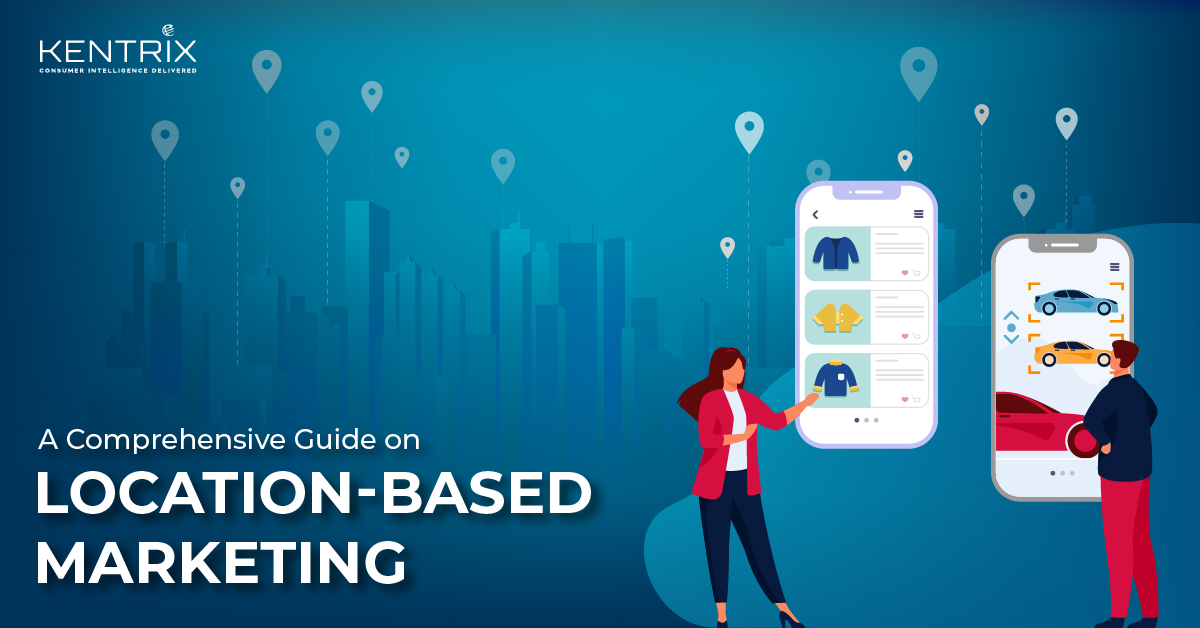You’re walking through a mall when a notification pops up on your phone: “20% off your favourite coffee, just 50 steps away.” Moments later, you see a digital screen outside the café advertising the same offer. This isn’t a coincidence — it’s location-based marketing in action.
By using your physical location, combined with your lifestyle preferences, brands can deliver messages that feel timely, relevant, and hard to ignore.

What Is Location Based Marketing?
Location-based marketing is a strategy that delivers personalized messages to people based on their physical location. Using technologies like GPS, Wi-Fi, IP addresses, and mobile signals, businesses can target customers when they are near a store, inside a mall, or even walking through a specific neighborhood.
It’s a powerful way to reach the right audience at the right time and right place. Location based marketing works best when combined with consumer data and lifestyle data. It helps brands create hyperlocal, real-time experiences that drive footfall, conversions and brand loyalty.
Location + Lifestyle Segmentation = Winning Formula
Location based marketing works best when combined with consumer behaviour and lifestyle segmentation. For example, showing the same ad to everyone in a 2 km radius may lead to low conversions because not everyone in that area is your target customer. But if you know that a certain apartment cluster has a high density of health-conscious, online-savvy households with above-average income, you can tailor your message to match their lifestyle, preferences, and spending power. This makes your outreach more relevant and likely to drive desired results.
When you overlay location data with insights like income, brand affinity, purchase patterns and lifestyle cohorts, that’s when you reach your target audience with pinpoint precision. That’s where Kentrix’s Geomarketeer stands apart. Unlike platforms that rely solely on GPS or mobile signals, Geomarketeer integrates location intelligence with household-level consumer data — including lifestyle segments (LSI), income, category affinity, digital behavior, and purchase power. This lets brands target not just by “where” the consumer is, but also by “who” they are and “what” they’re likely to respond to.
Benefits of Location Based Marketing
- Increases Footfall
By targeting people who are near your store with relevant, compelling offers, you can drive spontaneous visits. Increasing foot traffic to your store is a prime and most measurable benefit of location based marketing. This is quite effective for restaurants, service businesses or even retail brands.
- Better Relevance
Location-based marketing allows brands to reach people in very specific areas, from specific cities and towns to exact neighborhoods, streets, or even buildings. This level of precision makes your message more relevant to where the customer is at that moment. For example, someone near a café might receive a limited-time coffee offer, or a user entering a mall may see an ad for a brand’s ongoing in-store sale. Hyperlocal targeting captures user attention when it matters most. This makes your marketing campaigns feel more relevant and personal.
- Smarter Location Based Planning for ATL & BTL
Let’s take this further. Location based planning is not just about sending a personalised message on a phone. It can completely transform how brands plan their ATL and BTL.
Traditionally, brands would plan billboards, in-store promotions, or roadshows based on footfall estimates or blanket coverage across metros. But that often results in broad reach with low impact.
Modern location-based planning, however, answers sharper questions:
- Which localities house our ideal customer profile?
- What time does our audience visit malls, markets, or commute routes?
- Which fuel stations, screens, or residential pockets offer the best match for our brand?
With tools like Kentrix’s A.R.T. (Audience Reach Tool), marketers can pinpoint these sweet spots. This leads to:
- Hoardings placed only where the top 10% of your target demographic resides or moves.
- Sampling drives in residential complexes where product affinity is highest.
- Digital screen ads near retail zones with high purchase intent for your category.
The result? More conversions per rupee spent. Better ROI. Less waste. More control.
- Dynamic Pricing & Campaign Optimization
Demand in the real world fluctuates. Weekends bring different crowds than weekdays. A festival or a payday can spike purchasing power. A new business opening can change neighborhood dynamics.
With location-based intelligence, brands can dynamically adjust their campaign spend. Using predictive models, you can:
- Bid more during high-footfall hours
- Shift campaigns when local events change consumer flow
- Stay ahead of competition by booking high-value ad spaces before peak demand
Kentrix enables such dynamic decision-making with real-time location signals, household-level consumer data, and AI-backed forecasting.
- Higher ROI on ATL Spends
ATL campaigns like hoardings, transit branding, theatre ads and outdoor digital banners are often expensive. The challenge is not just reach, but also relevance.
Location intelligence makes ATL decisions more justifiable by:
- Identifying which screens or sites are exposed to your highest-value audiences.
- Calculating footfall-to-spend ratios, so you know if a ₹10 lakh campaign has a real conversion potential.
Prioritizing placement during high-impact periods, for example, advertising in areas with an upcoming event, new mall launch, or payday rush.
So instead of ATL being a branding expense, it becomes a precision-backed media investment.
- BTL Becomes More Personalised
BTL campaigns like roadshows, samplings, society activations, and store events work best when tailored to their micro-market. But most BTL strategies still rely on intuition or surface-level locality data.
With hyperlocal insights from Kentrix, brands can:
- Select societies where households match your product’s lifestyle or income bracket.
- Time activations when household presence is highest (e.g. evenings in gated communities).
- Run parallel digital campaigns that mirror the physical BTL effort for reinforcement.
This integrated planning reduces manual guesswork, improves on-ground team productivity, and makes BTL highly accountable.
How Does Kentrix’s Audience Research Tool Help in Location Based Marketing?
The Audience Reach Tool (A.R.T.) by Kentrix brings unmatched precision to location-based marketing. It goes beyond footfall estimates and generic targeting by combining geospatial data with consumer intelligence. Whether you’re planning an ATL campaign or a hyperlocal BTL activation, A.R.T. helps you reach the right audience at the right place and time — and proves impact with real-world data.
Here’s how A.R.T. adds value:
- Audience Profiling by Location: Know the detailed consumer profile of who you are reaching – their income, lifestyle segments, brand affinity, purchase intent, all this at each screen or catchment level.
- Smarter ATL/BTL Planning: Choose high-value locations for hoardings, retail screens, kiosks, or activations based on audience fit.
- Real-Time Optimization: Adjust campaigns dynamically using footfall trends, seasonal demand shifts, or local events.
- Performance Measurement: Access post-campaign reports showing which locations delivered the most engagement or footfall.
- Omnichannel Sync: Connect offline exposure (screens, events) with online journeys via digital retargeting or CRM integration.
- Predictive Intelligence: Identify emerging hotspots and plan ahead based on consumer movement and spending behavior.
With A.R.T., location-based marketing becomes measurable, agile, and sharply focused.
Conclusion
Location-based marketing has evolved far beyond geo-fencing and SMS alerts. Today, it sits at the heart of smarter media planning, more effective activations, and measurable brand-building. But to unlock its full potential, you need more than GPS and pin codes.
You need consumer intelligence, micro-market clarity, and the ability to connect places with people and purchase power.
With platforms like Geomarketeer and the Audience Reach Tool (A.R.T.), Kentrix is helping brands turn location into a strategic asset, not just for real-time targeting, but for long-term, data-backed go-to-market success.
Because in the end, it’s not about where your ad appears. It’s about where it matters.
FAQs
How can I measure the success of a location based marketing campaign?
You can track metrics like Success can be measured through metrics like footfall uplift, coupon redemptions, store visits, engagement with digital screens, POS data analysis, and customer repeat rates. Tools like A.R.T. offer dashboard-level visibility across all these parameters per location.
Which industries can benefit the most from location based marketing?
Industries like retail, QSR, BFSI, FMCG, hospitality, and consumer electronics benefit greatly. It helps them place campaigns near relevant outlets, stores, fuel stations, malls, or high-footfall zones. This drives both awareness and footfall.
How can I integrate location based marketing into my GTM strategy?
Start by identifying your top micro-markets and audience segments. Use tools like Geomarketeer to prioritize locations with the highest fit. Then plan ATL/BTL campaigns layered with digital outreach and measure performance with A.R.T.. This makes your GTM sharper and more localized.
What about data privacy in location based marketing?
Reputable platforms like Kentrix use anonymized, aggregated data compliant with data privacy regulations. No personally identifiable information (PII) is shared. The focus is on reaching lifestyle segments and households, not individuals. This ensures ethical and safe targeting.
Can you give few examples of location based marketing?
Here are some real-world examples of location-based marketing:
- A retail bank activates society-level campaigns in gated communities where people have higher affinity towards investment products.
- A consumer electronics brand runs hoardings only near premium residential areas with high-income, tech-savvy households, promoting its smart home devices.
- A D2C skincare brand places digital ads on screens in malls where footfall data shows a high density of female shoppers aged 25–40.


